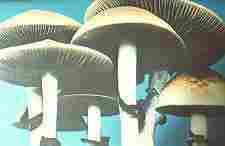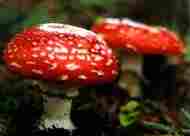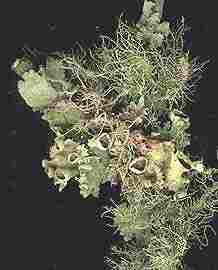
All fungi are heterotrophs, acquiring nutrients by absorption. In this mode of nutrition, small organic molecules are absorbed from the surrounding medium. A fungus digests its food by secreting powerful hydrolytic enzymes into food; the enzymes decompose complex molecules to simpler compounds that the fungus can absorb and use.
- Saprobic fungi: absorbs nutrients from nonliving organic material
- Parasitic fungi: absorb nutrients from the cells of living hosts
- Mutualistic fungi: also absorb nutrients from another organism, but they reciprocate with functions beneficial to their partner in some way
The vegetative bodies of fungi are constructed of hyphae. Hyphae are minute threads composed of tubular walls surrounding plasma membranes and cytoplasm. The hyphae form an interwoven mat called a mycelium. Most fungal hyphae are divided into cells by crosswalls, or septa. Coenocytic fungi consists of continuous cytoplasmic mass with hundreds or thousands of nuclei; these cells lack septa. Parasitic fungi have some of their hyphae modified as haustoria, nutrient-absorbing hyphal tips that penetrate the tissues of the host. Most fungi build their cell walls with chitin instead of cellulose.
A fungal mycelium grows rapidly by adding as much as a kilometer of hyphae each day with in a food source. Such fast growth is possible because cytoplasmic streaming to the tips of the extended hyphae channels proteins and other materials synthesized by the entire mycelium.
Fungi reproduce by releasing spores that are produced either sexual or asexually. The unicellular or multicellular spores are produced in specialized hyphal compartments. When conditions are stable, fungi clone themselves by producing enormous amounts of spores. The spores are spread by wind and water, and they germinate if they land in a moist place with a lot of substratum. Sexual reproduction is undertaken if there has been some change in the environment.
Fungi inhabit diverse environments and are associated symbiotically with many organisms. Fungi inhabit aquatic environments where they eat organic remains. Lichen is widespread and can even be found in places like Antarctica and the Arctic tundra. Other symbiotic fungi live inside the tissues of plants and insects.
Zygomycota: The zygote fungi of the division zygomycota, fungi that live in soil or decaying organic matter. Asexual spores develop in aerial sporangia. The division is named for its sexually produced zygosporangia, which are dikaryotic structures capable of persisting through unfavorable conditions.
Ascomycota: The sac fungi of the division ascomycota include plant parasites, fungal components of lichens, and saprobes. Asexual reproduction by conida is common. Sexual reproduction involves the formation of spores in sacs, or asci, at the ends of dikaryotic hyphae, usually in ascarps.
Basidiomycota: The club fungi of the division Basidomycota include mushrooms, shelf fungi, puff balls, and rusts. Sexual reproduction involves the formation of spores on club shaped basidia at the ends of dikaryotic hyphae in fruiting bodies, such as mushrooms.

Molds: are either asexual stages of fungi classified as zygomycota, ascomycota, or basidiomycetes, or conidia producing fungi. Molds are used commercially to produce antibiotics.Yeasts: are unicellular fungi adapted to life in liquids such as plant saps. They may be classified as ascomycetes, basidiomycetes, or devetromycetes.
Lichens: are such highly integrated symbiotic associations of algae and fungi that they are classified as a single organism. Lichens are rugged organisms that set the stage for plant growth by slowly breaking down bare rock.


